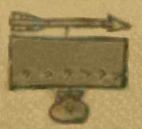Milpolco (T1735:2:109)
This compound glyph for the place name Milpolco ("In the Large Cornfield") consists of several elements. At the top is a frontal view of a horizontal arrow (mitl), painted green, and pointing toward the viewer's right. The arrow is playing a phonetic role, indicating that the place name begins with "Mi-". Below the arrow, and connected to it by a small line, is a large (-pol-), green, rectangular agricultural field (milli) with one row of U-shapes turned on their sides; this is typically a sign that the field is cultivated. Finally, at the bottom of this compound is a small pot or jug, probably ceramic, called a (comitl); this provides a phonetic indicator for the locative suffix (-co), at or on.
Stephanie Wood
The "-pol-" part of the place name could be reflected semantically in the way the field has only one row of symbols suggesting cultivation. Or perhaps the ceramic pot used for the locative suffix is small and miserable.
Stephanie Wood
milpulco
Milpolco
1566
sementeras, parcels, parcelas, agricultura, milpa, cerámica, barro, cántaros, ollas, flechas, arrows, jarras

mil(li), agricultural field, https://nahuatl.wired-humanities.org/content/milli
-pol-, large, https://nahuatl.wired-humanities.org/content/pol
-co (locative suffix), in or at, https://nahuatl.wired-humanities.org/content/co
En la Milpa Miserable
Stephanie Wood
Single-page codex, Archivo General de la Nación, México, Ramo de Tierras, vol. 1735, exp. 2, fol. 109.
The Archivo General de la Nación (AGN), México, holds the original manuscript. This image is published here under a Creative Commons license, asking that you cite the AGN and this Visual Lexicon of Aztec Hieroglyphs.


